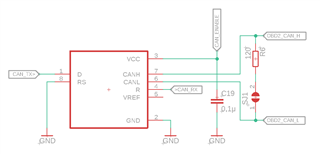Other Parts Discussed in Thread: SN65HVD231, , SN65HVD232, TCAN330
Hi team,
could you please review the following design? I am planning to use this CAN IC for communication between my car and ESP32 module.
The idea is to switch off the IC completely (CAN_ENABLE pin (GPIO HIGH/LOW) - 3,3V from ESP32 GPIO (max 40 mA)) when the communication is not needed to save some energy (internal battery is used - I am not using OBD2 12V pin). I know SN65HVD230 and SN65HVD231 offers some energy saving modes, but I would still prefer to shut down the IC completely.

If the design is OK, could you please tell me if it is a good idea to put a resistor between RS and GND pin, for example 10k? I have seen many application with such resistor, but I do not know the reason behind that.
I have also seen SN65HVD232, do you think it would be better option for my application (no RS and VREF pin)?
Thank you.



